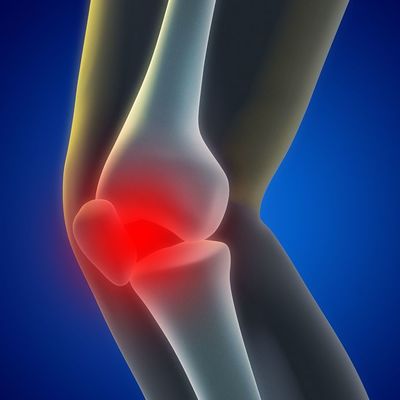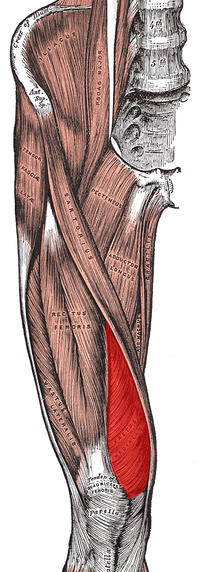Knee Pain
From Fellrnr.com, Running tips
Revision as of 18:49, 14 May 2012 by User:Fellrnr (User talk:Fellrnr | contribs) (Created page with "Knee pain is the most common injury for runners. This illustration shows the relationship between the kneecap and leg bones. A pain behin...")
A pain behind the kneecap (Patellofemoral pain syndrome or PFPS) is one of the most problems for runners[1]. There is no well-established cure for this problem[2], but there are a number of things you can try and some treatments to avoid.
1 Causes
There are a number of possible root causes of knee pain.
- Excessive stress. The kneecap is an amazing structure, but like all body parts, it has limits in the load it can take. This overload may be due to a number of factors.
- Low Cadence. Having a low Cadence results in more vertical movement, and thus higher landing forces.
- Highly cushioned shoes. Counterintuitively, the more cushioned your shoes are, the greater the loading force on your knees[3][4].
- Obesity. Obviously being overweight puts more stress on the knees and is linked to knee pain[5].
- Bad running form. Problems with running form, such as overstriding (landing with the foot ahead of the hip), can increase the landing forces and cause injury[6]. (See http://runningtimes.com/Print.aspx?articleID=23217 and http://runningtimes.com/Article.aspx?ArticleID=20271 for details on overstriding.)
- Inactivity. The human body needs activity to remain healthy, and the knee is a prime example of this. Animal studies have shown than complete immobilization of the knee can result in a 50% reduction in the cartilage thickness within weeks[7]. Thankfully this damage appears to be reversible.
- Maltracking/malalignment. The kneecap moves in a groove in the thigh bone (see image), and it is widely believed[8] that if the kneecap does not track in this grove it will rub on the sides and cause knee pain. However, this belief is not well supported by the evidence[9].
- Weak Quads. The alignment of the kneecap is not related to the overall strength of the quads, but rather an imbalance of the muscles that make up the quads. The quads consist of four muscles, and a relative weakness in one muscle, the Vastus Medialis Obliqus or VMO (see image), has been linked to kneecap alignment[10].
- Weak Hips. A weakness in the hip muscles has been linked to knee pain[11]. Weak hip muscles result in the leg rotating so the foot points towards the midline of the body (internal rotation), so when the leg bends extra stress is placed on the knee.
- Q angle. The thigh bone and lower leg are not in a straight line, but form an angle at the knee called the 'Q angle'. A large Q Angle is often thought to cause or contribute to knee pain, but a high Q angle was only seen in 6% of knee pain (PFPS) cases[1] and a high Q angle is not associated with biomechanical knee stress[12]. [[File:Q Angle.png|none|thumb|500px|If you draw an imaginary line from the front of the pelvis to the kneecap and from the lower leg to the kneecap, the angle between the lines is the Q Angle.]
- Over Pronation. Pronation is the natural movement of the foot where the arch flattens to absorb landing forces. If the foot pronates too much, the foot will lean towards the midline of the body and the lower leg and knee will follow this motion, moving towards the midline. Like weak hips, the movement of the knee towards the midline creates extra stress on the knee.
- Arthritis. Arthritis is an inflammation of the joints and can affect the knee. There are various types of arthritis, and diagnosis requires X-Ray, testing the fluid around the joint or inserting a viewing scope into the joint. Arthritis is outside of the scope of this article.
- Baker's cyst. A baker's cyst causes pain behind the knee joint rather than under the knee cap.
- ITBS. Another common source of knee pain is Iliotibial band syndrome which generally causes pain to the outside of the knee.
- Fracture. A fracture of the kneecap will obviously cause knee pain, but is normally the result of trauma. If you suspect you have a fractured kneecap, seek medical help.
- NSAIDs. Cartilage destruction is a major cause of concern with NSAIDs[13], but I found no long term studies that link NSAID use with knee problems, so it's not clear if this is a widespread cause of knee pain.
- Chondromalacia. The term Chondromalacia means soft cartilage and was once thought to be a common cause of knee pain. However, studies have shown that people with advanced Chondromalacia can be pain free[2].
2 Treatments
- Knee brace?
- Ice
- Cadence
- Minimalist shoes
- Downhill running
- Running form
- Glutes[14]
3 Anti-treatments
The following 'treatments' are not recommended.
- Quad strengthening. A common recommendation is to strengthen the quad muscles to improve the tracking of the kneecap, especially the VMO. However, resistance training of the quads puts extra strain on the kneecap and can cause a worsening of the symptoms[2].
- Surgery to correct mistracking. A study of knee pain indicated that this type of surgery has the second highest failure rate[2].
- NSAIDs. Using NSAIDs does not generally improve healing, can mask symptoms and is considered a cause of cartilage damage[13]. An animal study showed that Asprin resulted in greater cartilage degeneration[15]. More at NSAIDs and Running.
4 References
- ↑ 1.0 1.1 A retrospective case-control analysis of 2002 running injuries -- Taunton et al. 36 (2): 95 -- British Journal of Sports Medicine http://bjsm.bmj.com/content/36/2/95
- ↑ 2.0 2.1 2.2 2.3 Patellofemoral Pain Current Concepts: An Overview : Sports Medicine and Arthroscopy Review http://journals.lww.com/sportsmedarthro/Abstract/2001/10000/Patellofemoral_Pain_Current_Concepts__An_Overview.2.aspx
- ↑ Minimalist Footwear http://antonkrupicka.blogspot.com/2007/10/minimalist-footwear.html
- ↑ Factors related to the incidence of running injuries. A review. http://www.ncbi.nlm.nih.gov/pubmed/1615258
- ↑ THE ASSOCIATION OF KNEE INJURY AND OBESITY WITH UNILATERAL AND BILATERAL OSTEOARTHRITIS OF THE KNEE http://aje.oxfordjournals.org/content/130/2/278.short
- ↑ Mechanisms of Selected Knee Injuries http://physicaltherapyjournal.com/content/60/12/1590.short
- ↑ Response of joint structures to inactivity and to reloading after immobilization - Brandt - 2003 - Arthritis Care & Research - Wiley Online Library http://onlinelibrary.wiley.com/doi/10.1002/art.11009/full
- ↑ Knee Injuries From Running at Runner's World.com http://www.runnersworld.com/article/0,7120,s6-241-285--7773-0,00.html
- ↑ The role of patellar alignment and tracking in vivo: The potential mechanism of patellofemoral pain syndrome http://www.sciencedirect.com/science/article/pii/S1466853X11000162
- ↑ Role of the vastus medialis obliquus in repo... [Am J Sports Med. 2008] - PubMed - NCBI http://www.ncbi.nlm.nih.gov/pubmed/18337358
- ↑ Hip strength and hip and knee kine... [J Orthop Sports Phys Ther. 2008] - PubMed - NCBI http://www.ncbi.nlm.nih.gov/pubmed/18349475
- ↑ Greater Q angle may not be a ri... [Clin Biomech (Bristol, Avon). 2011] - PubMed - NCBI http://www.ncbi.nlm.nih.gov/pubmed/21177007
- ↑ 13.0 13.1 ScienceDirect.com - The American Journal of Medicine - Profile and mechanisms of gastrointestinal and other side effects of nonsteroidal anti-inflammatory drugs (NSAIDs) http://www.sciencedirect.com/science/article/pii/S0002934399003654
- ↑ Gluteal muscle activation durin... [Clin Biomech (Bristol, Avon). 2011] - PubMed - NCBI http://www.ncbi.nlm.nih.gov/pubmed/21388728
- ↑ In vivo effect of aspirin on canine osteoarthritic cartilage - Palmoski - 2005 - Arthritis & Rheumatism - Wiley Online Library http://onlinelibrary.wiley.com/doi/10.1002/art.1780260808/abstract


